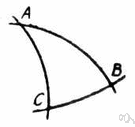The spherical triangle in this form is known as the Reuleaux triangle, after Franz Reuleaux, who realized that it would roll with a constant diameter.
Moreover, some of the approaches on these pages involve explicit visualization of the spherical octant as a Reuleaux-like spherical triangle, which may well have been what suggested the Reuleaux triangle approach to Da Vinci for his world map.
A "triangle" in elliptic geometry, such as ABC, is a
spherical triangle (or, more precisely, a pair of antipodal
spherical triangles).
Then, notice that [[angle].sub.P]AOB is equal to the interior angle [angle]P of the
spherical triangle [delta]APB, because the tangent plane of [S.sup.2] at P is orthogonal to the line OP.
Consider
spherical triangle [DELTA]ABC with vertex C at the North Pole (Fig.
The consequence of the unperceivability of depth that will be important for us is this: every visible triangle is indistinguishable from some
spherical triangle. That is, for any triangle that I see, there is a corresponding triangle composed of segments of great circles centered on my eye; the sides of this
spherical triangle share endpoints with the sides of the original triangle, but curve out away from my eye.
Then, from the
spherical triangle between N, V and R, using the law of cosines for sides, we find the angle between the transmitter's velocity vector and the receiver:
An alternative way of viewing the Delaunay triangulation is as follows: the planar triangle corresponding to each
spherical triangle lies on the boundary of the convex hull of the nodes (as elements of [R.sup.3]).
A
spherical triangle is defined in terms of a unit sphere -- that is, a sphere of radius one (1).
Given a
spherical triangle containing an interpolation point p, along with vertex values and gradients, evaluation of the interpolant requires Hermite cubic interpolation along six arcs: the triangle sides and each of the three arcs that connect a vertex to the opposite side and contain p.
Gradually, researchers have developed theories on intersecting circles, which led to divergent properties between circular triangles and
spherical triangles. The introduction of fuzzy sets and systems by Zadeh [1] changed the face of research in trigonometry.
For this purpose, the observatory staff used the equipment at night, when it was not being used for Almanac computations, and calculated solutions to a quarter of a million
spherical triangles to locate the real-time positions of enemy U-boats within five miles.
 spherical triangle - a spherical polygon formed by the arcs of 3 great circles
spherical triangle - a spherical polygon formed by the arcs of 3 great circles